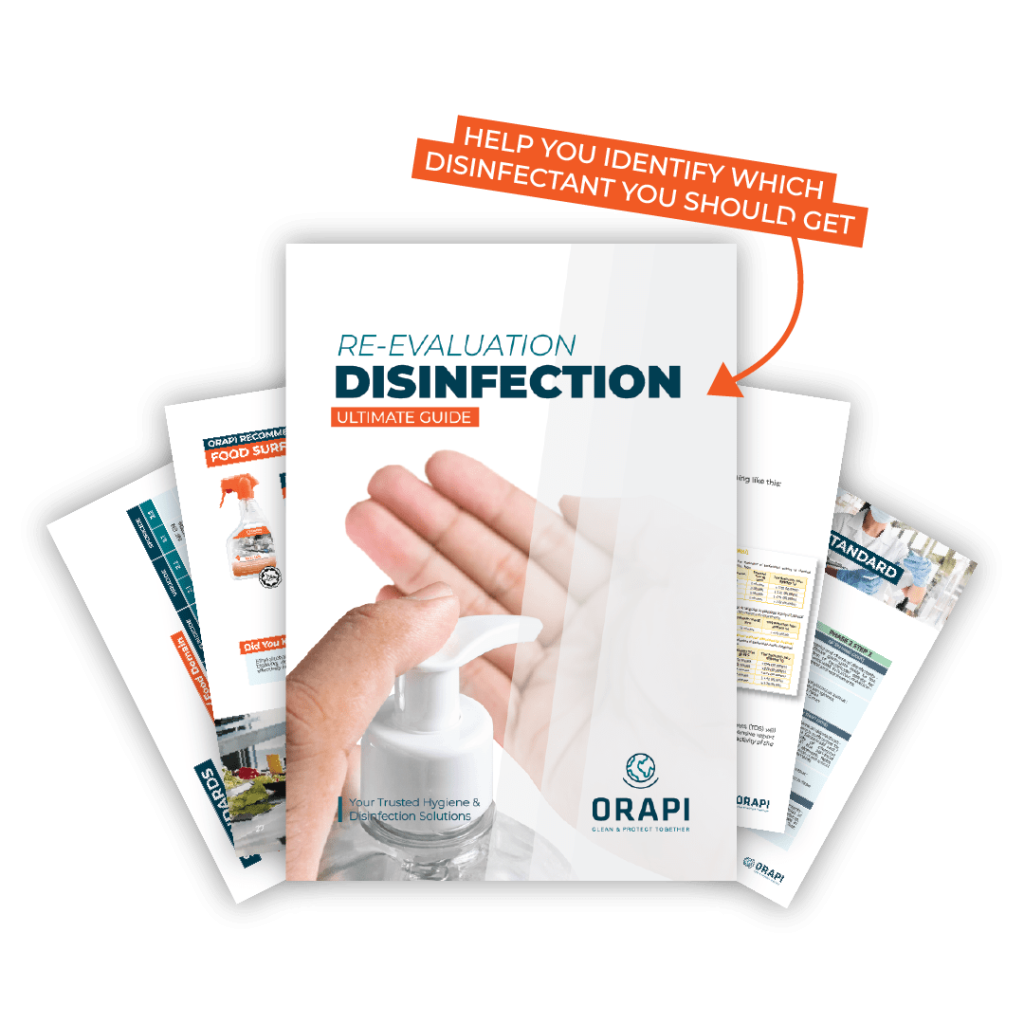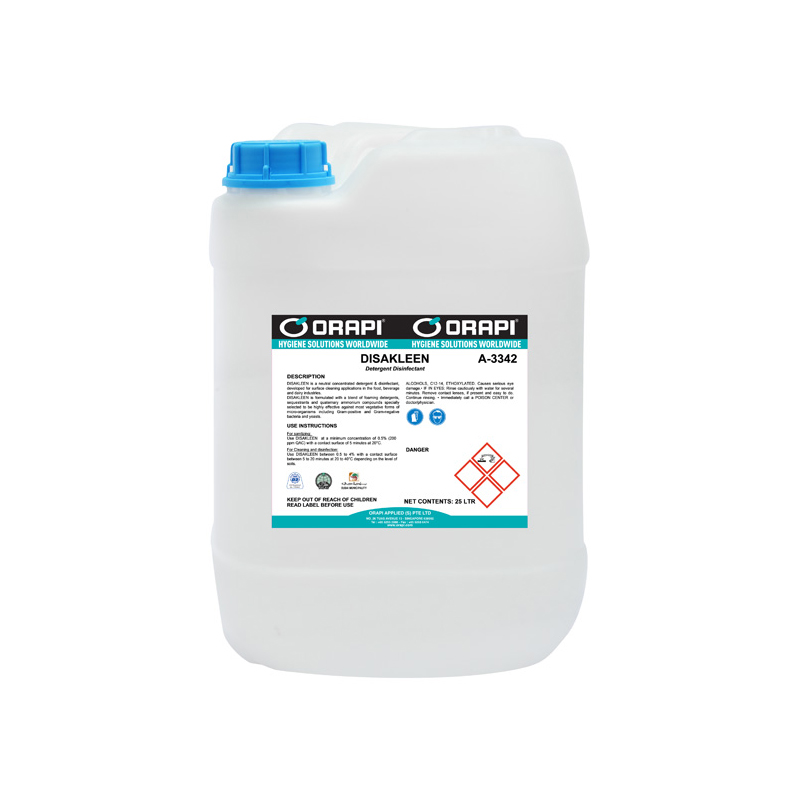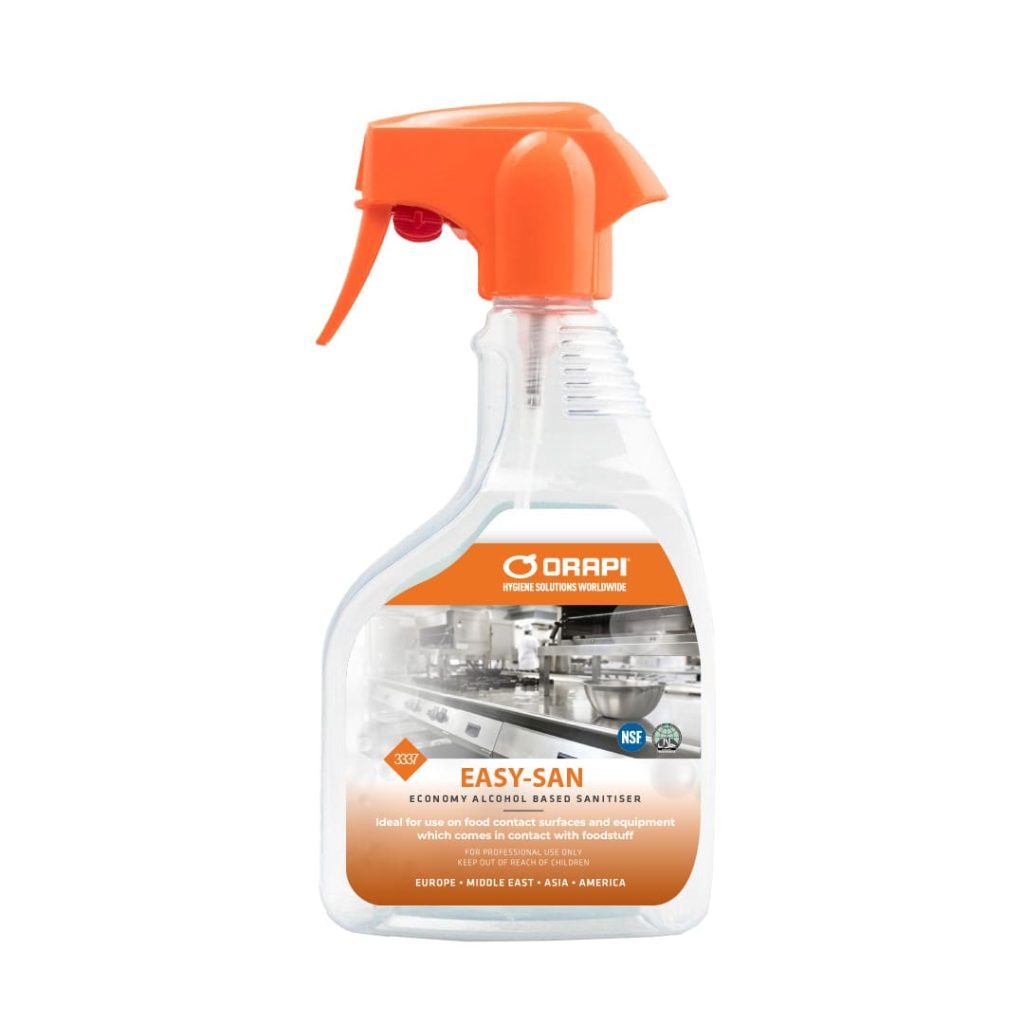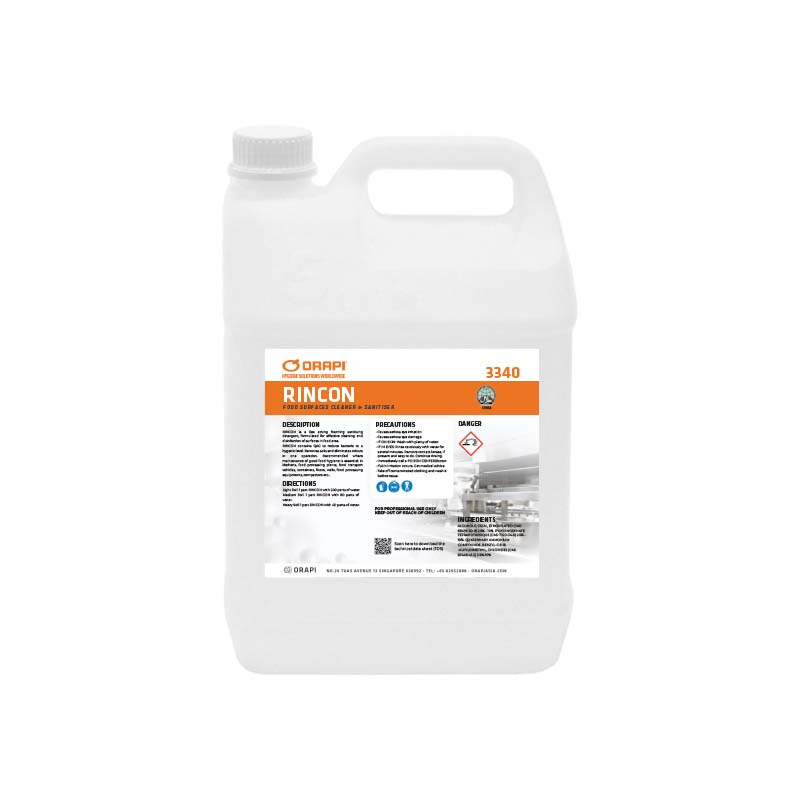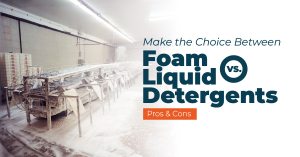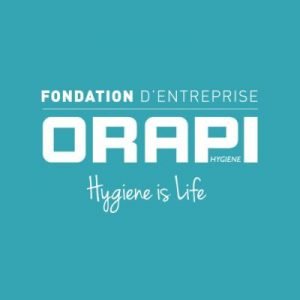
In the battle against germs and contaminants, our first line of defence is often the simplest: cleaning. But when it comes to ensuring the safety and cleanliness of our environments, the terms “cleaning,” “sanitising,” and “disinfecting” are frequently used interchangeably, causing confusion about their true purposes and effectiveness. So, to answer the question ‘What is the difference between sanitising and disinfecting?’, you must first understand the distinctions among these processes: cleaning, the initial step in the hygiene hierarchy, rids surfaces of dirt and organic matter using soap or detergents. Sanitising follows, using chemicals to eliminate bacteria, while disinfecting goes a step further by not only vanquishing bacteria but also targeting viruses. In this article, we shed light on the concept of sanitising to maintain a clean and safe environment.
Effectiveness Standards

Evaluation the effectiveness of disinfectants and sanitisers is the first measure of consideration when attempting to answer the questions ‘what is the difference between sanitising and disinfecting’. Disinfectants vary in effectiveness, even though they must meet identical acceptance standards. Some disinfectants are more efficient at lower concentrations and act more quickly, among other factors. Consequently, both concentration and contact time are crucial considerations. Nevertheless, in most food processing facilities, the primary concern lies with pathogens such as Listeria monocytogenes, Salmonella, pathogenic Escherichia coli, etc. The acceptance criteria for sanitisers remain consistent, regardless of whether they contain quaternary ammonium, chlorine, iodine, or other active ingredients. However, when faced with the task of eradicating a resident population of L. monocytogenes or E. coli, it becomes apparent that not all sanitisers perform equally.
The EPA document OCSPP 810.2300: Sanitisers for Use on Hard Surfaces
For non-food contact surfaces, a successful sanitising process is defined by efficacy data recommendations that demonstrate a reduction of at least 99.9 percent (a 3-log₁₀ reduction) in the number of each test microorganism over the parallel control count within 5 minutes. On the other hand, for food contact surfaces, the requirement is to evaluate the sanitising success of non-halide formulations. Acceptable results should demonstrate a reduction of greater than or equal to 99.999 percent in the number of each test microorganism within 30 seconds. It’s important to note that the test organisms differ depending on whether the test is for food contact or non-food contact surfaces. In both cases, there are at least two microorganisms, one Gram-positive and one Gram-negative.
The EPA document OCSPP 810.2200: Disinfectants for Use on Environmental Surfaces
When it comes to testing the effectiveness of disinfectants, a 6-log reduction or 99.9999 percent reduction in harmful microorganisms is required within 10 minutes for both food and non-food contact surfaces. Disinfectants are typically chemical agents that target disease-causing pathogens, although they may not be effective against bacterial spores. The EPA categorises disinfectants as “limited,” “general,” or “hospital” disinfectants based on their label claims. In the food industry, a “limited” label claim indicates that only one of the two types of test organisms met the reduction criteria, while a “general” label claim suggests that both types of test organisms were reduced to meet the acceptable standards.
What Is the Difference Between Sanitising and Disinfecting?
The choice between sanitisation and disinfection depends on the specific target organisms and the desired level of log reduction. The EPA defines disinfection as the process used on inanimate surfaces and objects to eliminate infectious fungi and bacteria, excluding their spores, while sanitisation reduces but does not necessarily eliminate microorganisms to levels considered safe by public health standards. In food processing, equipment and production environments are typically sanitised. Some products may be labelled for both purposes, but it’s essential to check the product label or technical data sheet, as contact times and concentrations can vary. It’s also crucial to ensure that the treated surface remains wet for the specified duration, particularly in low-humidity environments where products with a 10-minute contact time may need reapplication at intervals to achieve the desired log reduction.
DISAKLEEN is a neutral concentrated detergent & disinfectant, developed for surface cleaning applications in the food, beverage and dairy industries. It also is formulated with a blend of foaming detergents, sequestrants and quaternary ammonium compounds specially selected to be highly effective against most vegetative forms of micro-organisms including Gram-positive & Gram-negative bacteria & yeasts, and enveloped viruses.
Is Rotating Sanitisers Necessary?

People question the necessity of rotating sanitisers. The response isn’t straightforward, as it hinges on the underlying rationale for rotation. Occasionally, sanitisers are switched out due to the belief that microorganisms are developing resistance to a particular sanitiser. However, this assumption is often inaccurate. Instead, apparent sanitiser inefficacy is more likely due to the following factors:
Insufficient Cleaning
Neglecting to execute the seven essential cleaning steps can result in the retention of organic matter on surfaces, potentially causing it to react with the sanitiser and rendering it ineffective.
Inadequate Equipment Design
Equipment with suboptimal design may give rise to hidden crevices that serve as shelter for microorganisms, facilitating the formation of biofilms.
Improper Application
Applying the sanitiser sparingly, failing to cover the entire surface, or not maintaining surface wetness for the required duration can contribute to ineffective sanitisation.
Biofilm Presence
Sanitiser Tolerance and Biofilm Formation

When biofilms develop, microbial populations can acquire a degree of tolerance to sanitisers. This occurs because the sanitiser may struggle to effectively penetrate the protective biofilm. It’s important to note that the effectiveness of sanitisers, as evaluated by the EPA, typically does not account for biofilm presence. In practical scenarios, if bacteria are able to establish a residence and form a biofilm, the routinely used sanitiser might lack the required properties to eradicate this protective layer.
Sanitiser Resistance
Sanitiser resistance is typically associated with acquired resistance, wherein the organism obtains genes that allow resistance. For instance, a microorganism can become resistant to an antibiotic because it acquired genes that enable it to metabolise the antibiotic.
In the case of sanitisers, resistance is relatively uncommon. However, an exception exists in the resistance to sanitisers containing quaternary ammonium compounds (QACs). Several studies have linked the presence of specific genes to the survival of various microorganisms when exposed to QACs. For instance, Katharios-Lanwermeyer et al. demonstrated the transfer of resistance to benzalkonium chloride (BC) from nonpathogenic Listeria spp. to Listeria monocytogenes. More recently, Cooper et al. analysed the genomes of 1,279 well-characterised L. monocytogenes isolates from diverse food sources and food manufacturing environments, identifying the bcrABC gene cassette associated with BC resistance in 41.5 percent of the isolates.
Choosing a Sanitiser
When it comes to selecting a sanitiser, several factors demand consideration:
- Nature of the Process: In certain cases, a sanitiser that leaves behind a residue may not be suitable for use in fermentation processes.
- Target Organisms: It’s vital to consider the specific microorganisms you aim to combat, not only from a pathogenic standpoint but also in terms of preventing spoilage. Just like disinfectants, some sanitisers may exhibit varying levels of effectiveness against distinct microbial groups.
- Hardness of Water
- Materials used in the construction of both the environment and equipment
- Wastewater Treatment: If your facility has a wastewater treatment system in place, the type of sanitiser you use can impact its efficiency.
- Product Type: The nature of the products manufactured is an important consideration. Certain sanitisers may be restricted or prohibited in organic facilities.
- Cost
ORAPI RECOMMENDS:
Economy Alcohol Based Sanitizer
Dealing With Resistant Biofilms

In certain scenarios, our environmental samples persistently return positive results or fall outside specified limits, such as for Listeria spp. and various microorganisms. Our cleaning and sanitising procedures may inadvertently encourage contamination rather than eradicate it. The culprit in such cases could be the presence of a stubborn biofilm. Once a biofilm takes hold, its removal becomes challenging, particularly when it forms in hard-to-reach locations. While mechanical methods are usually effective in biofilm removal, they may not always be feasible. For instance, if a biofilm has developed beneath equipment and is leaching out, attempting to lift and thoroughly clean the equipment may not be a practical solution.
In such situations, alternative sanitation or disinfection approaches become necessary. This may entail utilising physical treatments like heat or opting for different sanitisers or combinations thereof. In the past, our choices were somewhat limited, encompassing chlorine, quaternary ammonium compounds, iodine, and, for the more daring, chlorine dioxide. Today, we have safer and more convenient options, such as using chlorine dioxide in aqueous or gaseous forms, as well as “newer” chemical combinations like PAA or even more sophisticated formulations designed to penetrate cracks and crevices, effectively eliminating the microbes within the biofilm and dissolving it.
As previously mentioned, both the concentration and contact time are crucial factors, especially when dealing with biofilms, as they are less effective against microbes if not applied at recommended levels. Certain sanitisers are designed to remain present and active on surfaces for longer durations than typically required in the approval protocols for sanitisers and disinfectants. Given the complexity of substances within biofilms, it takes more time for a sanitiser to penetrate and reach the microorganisms responsible for forming it. Consequently, the standard contact times of 30 seconds to 10 minutes may prove insufficient, depending on the chosen sanitiser.
Moreover, chlorine dioxide has proven more effective than chlorine in combating biofilms. Increasing concentrations and contact times may also yield positive results. For example, the application of PAA at approximately 1,000 ppm and keeping the surface wet for over 20 minutes can be effective, provided that it will be rinsed at a no-rinse concentration on surfaces in contact with food. Other specially formulated sanitisers can also be highly efficient. For instance, Wang et al. demonstrated the effectiveness of a multicomponent sanitiser comprising a quaternary ammonium compound, hydrogen peroxide, and diacetin in inactivating and removing biofilms formed by Escherichia coli O157:H7 and Salmonella enterica in meat processing facility conditions.
Following the application of these treatments, verifying their effectiveness by continuing to sample for the pathogen or indicator of concern after the treatment is crucial. Sampling should be conducted for several weeks, ideally a minimum of 3 consecutive weeks. If locations that tested positive are not already part of the routine environmental sampling program, they should be included to ensure early detection of any biofilm resurgence.
Fogging

When applying sanitiser on a surface, fogging can be a cost-effective method that involves using a smaller amount of sanitiser. However, it faces a challenge when conditions facilitate the rapid evaporation of the sanitiser. The desired effect may not be achieved in such cases as the required contact time is not met. It is essential to consider this when using a disinfectant with a 10-minute contact time. Moreover, during fogging, the droplets may not cover all the cracks where there could be pathogens. If the sanitiser does not come into contact with the microorganisms, it will be unable to eliminate them.
ORAPI RECOMMENDS:
RINCON is a foaming sanitizing detergent formulated for effectively cleaning and disinfecting surfaces in food areas.
RINCON is formulated with a blend of detergents, sequestrants and quaternary ammonium compounds specially selected to be effective against a wide range of microorganisms for maximum hygiene.
Conclusion: What Is the Difference Between Sanitising and Disinfecting
In conclusion, to answer the question ‘what is the difference between sanitising and disinfecting’, you have to bear a few things in mind: firstly, when applied at the recommended concentration and contact duration, sanitisers can effectively eliminate microorganisms on clean surfaces. It’s important to note that when dealing with viruses, a disinfectant is necessary. Furthermore, in cases where a microbial population forms a biofilm, it may develop resistance to the initial sanitiser, requiring an alternative product capable of penetrating the biofilm and eradicating the microorganisms within. It is crucial to be aware that sanitiser regulations can differ between countries, making it essential to verify and adhere to these regulations in the exporting countries to ensure compliance.
@orapi_recommends Sanitising, disinfecting, or are they the same? 🦠 Many people confuse sanitising and disinfecting or assume that sanitising is enough to kill all germs. 🧽 When in reality, they are two different processes, serving different purposes. Watch Erica from ORAPI explain the difference between sanitising and disinfecting with EXAMPLES! #Sanitising #Disinfecting #cleantok ♬ In Love With You - BLVKSHP
